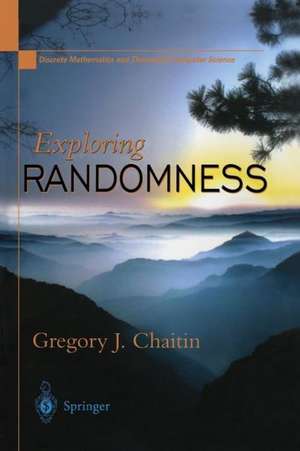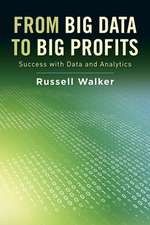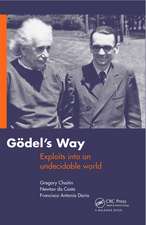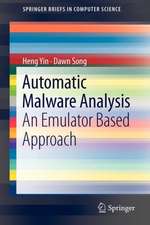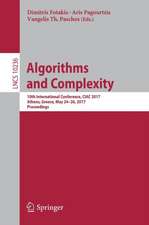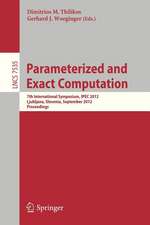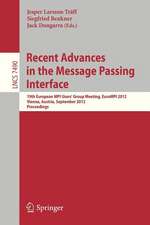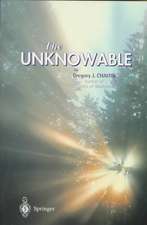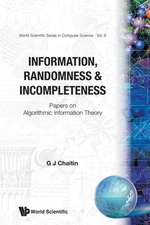Exploring RANDOMNESS: Discrete Mathematics and Theoretical Computer Science
Autor Gregory J. Chaitinen Limba Engleză Paperback – 17 oct 2012
| Toate formatele și edițiile | Preț | Express |
|---|---|---|
| Paperback (1) | 696.63 lei 6-8 săpt. | |
| SPRINGER LONDON – 17 oct 2012 | 696.63 lei 6-8 săpt. | |
| Hardback (1) | 645.97 lei 6-8 săpt. | |
| SPRINGER LONDON – 11 dec 2000 | 645.97 lei 6-8 săpt. |
Preț: 696.63 lei
Preț vechi: 870.79 lei
-20% Nou
Puncte Express: 1045
Preț estimativ în valută:
133.30€ • 139.55$ • 110.30£
133.30€ • 139.55$ • 110.30£
Carte tipărită la comandă
Livrare economică 05-19 aprilie
Preluare comenzi: 021 569.72.76
Specificații
ISBN-13: 9781447110859
ISBN-10: 1447110854
Pagini: 180
Ilustrații: X, 164 p.
Dimensiuni: 155 x 235 x 9 mm
Greutate: 0.26 kg
Ediția:Softcover reprint of the original 1st ed. 2001
Editura: SPRINGER LONDON
Colecția Springer
Seria Discrete Mathematics and Theoretical Computer Science
Locul publicării:London, United Kingdom
ISBN-10: 1447110854
Pagini: 180
Ilustrații: X, 164 p.
Dimensiuni: 155 x 235 x 9 mm
Greutate: 0.26 kg
Ediția:Softcover reprint of the original 1st ed. 2001
Editura: SPRINGER LONDON
Colecția Springer
Seria Discrete Mathematics and Theoretical Computer Science
Locul publicării:London, United Kingdom
Public țintă
ResearchCuprins
I Introduction.- Historical introduction—A century of controversy over the foundations of mathematics.- What is LISP? Why do I like it?.- How to program my universal Turing machine in LISP.- II Program Size.- A self-delimiting Turing machine considered as a set of (program, output) pairs.- How to construct self-delimiting Turing machines: the Kraft inequality.- The connection between program-size complexity and algorithmic probability: H(x) = ? log2P(x) +O(1). Occam’s razor: there are few minimum-size programs.- The basic result on relative complexity: H(y?x) = H(x,y)-H(x)+O(1).- III Randomness.- Theoretical interlude—What is randomness? My definitions.- Proof that Martin-Löf randomness is equivalent to Chaitin randomness.- Proof that Solovay randomness is equivalent to Martin-Löf randomness.- Proof that Solovay randomness is equivalent to strong Chaitin randomness.- IV Future Work.- Extending AIT to the size of programs for computing infinite sets and to computations with oracles.- Postscript—Letter to a daring young reader.
Recenzii
From the reviews:
"In this book on algorithmic information theory, the author compares his concept of randomness (for recursive functions) which is based on the complexity (length) of the generating algorithm (program) with other concepts (by Martin-Löw, Solovay) and discusses its relation to incompleteness and the halting problem. Algorithms (needed for proof) are described in a (small) dialect of LISP. The style mostly is that of a lecture, lively and readable." (P. Schmitt, Monatshefte für Mathematik, Vol. 141 (1), 2004)
"Chaitin is the main architect of a new branch of mathematics called algorithmic information theory, or ‘AIT’. … in Exploring Randomness, he develops algorithmic theory, further revealing its technical core. This is important work, with implications that go far beyond the arcane arguments of one branch of mathematics. … As one gets to the substance … it is difficult to resist Chaitin’s enthusiastic style and obvious intelligence. Beyond the technicalities of the argument, the reader is quickly drawn into a fundamental new landscape of ideas." (Jacques F. Vallee, Journal of Scientific Exploration, Vol. 16 (4), 2002)
"Chaitin’s latest three books form a nice triangular base to support and explore the concepts underlying algorithmic information theory (AIT) – a clever blend of Gödel, Turing, and Shannon that Chaitin developed in his late teens … . this set of three volumes packages the material in a nice, quite digestible fashion … . Chaitin’s results demonstrate that not only there is no structure to foundation of mathematics, the foundation is in fact random." (The Mathematica Journal, April, 2002)
"The book is devoted to a Lisp formalism for exploring the basic ideas, concepts and results on program-size complexity and random sequences. The book contains a wealth of exercises, ranging from the ‘mathematical equivalent of finger warm-ups for pianists’ to substantial programmingprojects, from open questions to questions the author cannot even formulate. Highly recommended to anyone interested in understanding algorithmic information theory through programming." (Cristian S. Calude, Zentralblatt MATH, Vol. 963, 2002)
"This book uses LISP to explore the theory of randomness, called algorithmic information theory (AIT). This is the third of Chaitin’s book … . The common theme of the books is the study of H(x), the size in bits of the smallest program for calculating x … . Each book has a different emphasis. This book gives a detailed discussion of the metamathematical implications of these ideas and presents the technical core of Chaitin’s algorithmic theory." (Book News on the Internet, October, 2001)
"This is revolutionary, explosive stuff. … Chaitin challenges readers to follow his lead and forge their own path into the black hole of randomness, the ‘darkness at the edge of mathematics’. When Chaitin wrote ‘explore’, he well and truly meant it. An exhilarating, mind-blowing book from one of the great ideas men of mathematics and computer science." (Marcus Chown, New Scientist, January, 2002)
"In this book on algorithmic information theory, the author compares his concept of randomness (for recursive functions) which is based on the complexity (length) of the generating algorithm (program) with other concepts (by Martin-Löw, Solovay) and discusses its relation to incompleteness and the halting problem. Algorithms (needed for proof) are described in a (small) dialect of LISP. The style mostly is that of a lecture, lively and readable." (P. Schmitt, Monatshefte für Mathematik, Vol. 141 (1), 2004)
"Chaitin is the main architect of a new branch of mathematics called algorithmic information theory, or ‘AIT’. … in Exploring Randomness, he develops algorithmic theory, further revealing its technical core. This is important work, with implications that go far beyond the arcane arguments of one branch of mathematics. … As one gets to the substance … it is difficult to resist Chaitin’s enthusiastic style and obvious intelligence. Beyond the technicalities of the argument, the reader is quickly drawn into a fundamental new landscape of ideas." (Jacques F. Vallee, Journal of Scientific Exploration, Vol. 16 (4), 2002)
"Chaitin’s latest three books form a nice triangular base to support and explore the concepts underlying algorithmic information theory (AIT) – a clever blend of Gödel, Turing, and Shannon that Chaitin developed in his late teens … . this set of three volumes packages the material in a nice, quite digestible fashion … . Chaitin’s results demonstrate that not only there is no structure to foundation of mathematics, the foundation is in fact random." (The Mathematica Journal, April, 2002)
"The book is devoted to a Lisp formalism for exploring the basic ideas, concepts and results on program-size complexity and random sequences. The book contains a wealth of exercises, ranging from the ‘mathematical equivalent of finger warm-ups for pianists’ to substantial programmingprojects, from open questions to questions the author cannot even formulate. Highly recommended to anyone interested in understanding algorithmic information theory through programming." (Cristian S. Calude, Zentralblatt MATH, Vol. 963, 2002)
"This book uses LISP to explore the theory of randomness, called algorithmic information theory (AIT). This is the third of Chaitin’s book … . The common theme of the books is the study of H(x), the size in bits of the smallest program for calculating x … . Each book has a different emphasis. This book gives a detailed discussion of the metamathematical implications of these ideas and presents the technical core of Chaitin’s algorithmic theory." (Book News on the Internet, October, 2001)
"This is revolutionary, explosive stuff. … Chaitin challenges readers to follow his lead and forge their own path into the black hole of randomness, the ‘darkness at the edge of mathematics’. When Chaitin wrote ‘explore’, he well and truly meant it. An exhilarating, mind-blowing book from one of the great ideas men of mathematics and computer science." (Marcus Chown, New Scientist, January, 2002)
